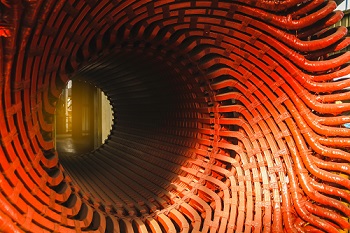What is Partial Discharge?
What is Partial Discharge?
PD is an electrical discharge that occurs at a specific point on an insulator.
Fig.1 is a general partial discharge occurrence model, and showing an insulation sandwiched by electrodes. In the insulation, there are voids (impurities).
Dielectric constant of the voids is usually lower than that in the surrounding dielectric. Therefore when AC voltage is applied to the insulation, voltage in the voids becomes larger, and as a result, the voids short itself out, while the insulation is not shorted.
The short circuit in the voids leads to small charge-transfers, and this is called partial discharge.
Points
1. Partial discharge occurs within voids (impurities) due to the lower insulating strength.
2. Electric field tends to concentrate on the voids, because dielectric constant of voids is lower than that of main insulations. As a result, local insulation breakdown in the voids occurs.
3. The insulation strength of voids depends on the type of gas, gas pressure in the void and void dimension.
4. Partial discharge precedes insulator breakdown.
5. Partial discharge is described by the maximum discharged charge (Q-max pC).
Why is Partial Discharge Test important?

Even with a stringent manufacturing process, it is not always possible to manufacture solid insulation without creating voids (impurities). Generally, the void in solid insulation is filled with a gas, and it has lower breakdown strength than the main material. In addition, the permittivity of the void is invariably lower than that of main insulation, and electric field tends to concentrate on the void. Thus, even under normal working stress, the voltage across the void may exceed the breakdown value and partial discharge occurs. When partial discharge begins and repeats, it can damage the materials and may lead to failure of the whole high voltage power equipment. To secure safety of electrical appliances, quality of insulation must be regarded as the most important matter.
Partial discharge measurements are desirable test to find insulation defects and early failures in insulation materials.
Periodic diagnosis enhances safety of electrical appliances, and can help to find symptoms before becoming a failure.
SOKEN Partial Discharge Testers

APPLICATION
- Insulation degradation analysis.
- Detection of locations that need maintenance.
- Predict life expectancy.
- Efficiently plan maintenance and repairs.
- Quality check during the manufacturing process.
Generators, Motors, EV Motors, Transformers,
Cables, Capacitors, Insulating materials,
Coils, Bushings, Circuit Breakers,
Magnet wires, printed circuit boards,
connectors, semiconductors, electrostatic chucks
IGBT gate drive, photo couplers/Optocouplers
SOKEN provides PD testers that comply with IEC 60270 and IEC60664-1, which are often referenced in PD test for other IEC standards.
SOKEN PD TESTER LINE-UP.

